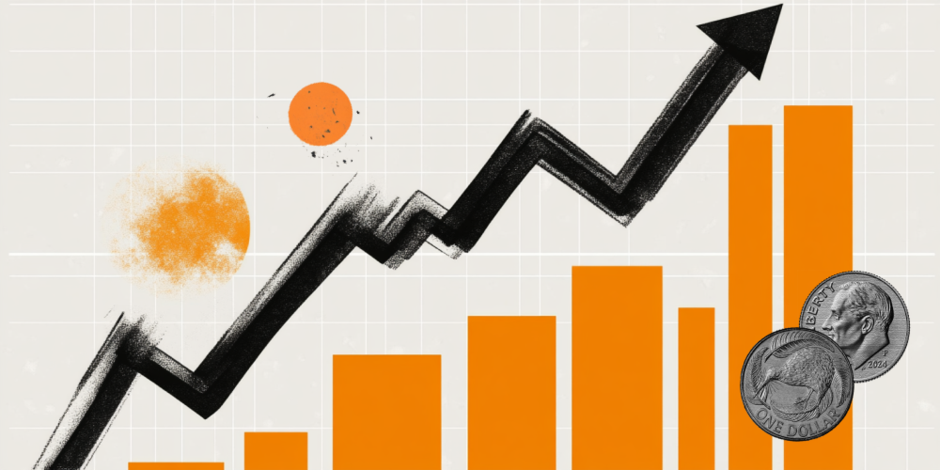NZD/USD holds positive ground near 0.5900 as New Zealand Retail Sales beat expectations
- NZD/USD edges higher to around 0.5900 in Friday’s early Asian session.
- New Zealand Retail Sales beat expectations in Q1.
- A stronger US S&P Global PMI might cap the pair's upside.

The NZD/USD pair posts modest gains near 0.5900 during the early Asian session onn Thursday. The upbeat New Zealand Retail Sales data provide some support to the Kiwi against the US Dollar (USD). Traders will keep an eye on the speeches from the Federal Reserve (Fed) officials later on Friday, including Alberto Musalem, Jeff Schmid and Lisa Cook.
New Zealand Retail Sales were stronger than expected in the first quarter (Q1) this year as interest-rate cuts triggered improved consumer demand and confidence. The country’s Retail Sales rose 0.8% QoQ in Q1 from the previous reading of 0.9%, according to the official data published by Statistics New Zealand on Friday. The upbeat New Zealand economic data underpin the China-proxy Kiwi, as China is a major trading partner of New Zealand.
On the other hand, the stronger US S&P Global Purchasing Managers Indices (PMIs) might boost the Greenback and drag the pair lower. Fed Governor Christopher Waller said that markets are monitoring fiscal policy. Waller further stated that if tariffs are close to 10%, the economy would be in good shape for H2, and the Fed could be in a position to cut later in the year. Markets have priced in nearly a 71% chance that the Fed would keep its interest rates steady through its next two meetings, according to the CME FedWatch tool.
New Zealand Dollar FAQs
The New Zealand Dollar (NZD), also known as the Kiwi, is a well-known traded currency among investors. Its value is broadly determined by the health of the New Zealand economy and the country’s central bank policy. Still, there are some unique particularities that also can make NZD move. The performance of the Chinese economy tends to move the Kiwi because China is New Zealand’s biggest trading partner. Bad news for the Chinese economy likely means less New Zealand exports to the country, hitting the economy and thus its currency. Another factor moving NZD is dairy prices as the dairy industry is New Zealand’s main export. High dairy prices boost export income, contributing positively to the economy and thus to the NZD.
The Reserve Bank of New Zealand (RBNZ) aims to achieve and maintain an inflation rate between 1% and 3% over the medium term, with a focus to keep it near the 2% mid-point. To this end, the bank sets an appropriate level of interest rates. When inflation is too high, the RBNZ will increase interest rates to cool the economy, but the move will also make bond yields higher, increasing investors’ appeal to invest in the country and thus boosting NZD. On the contrary, lower interest rates tend to weaken NZD. The so-called rate differential, or how rates in New Zealand are or are expected to be compared to the ones set by the US Federal Reserve, can also play a key role in moving the NZD/USD pair.
Macroeconomic data releases in New Zealand are key to assess the state of the economy and can impact the New Zealand Dollar’s (NZD) valuation. A strong economy, based on high economic growth, low unemployment and high confidence is good for NZD. High economic growth attracts foreign investment and may encourage the Reserve Bank of New Zealand to increase interest rates, if this economic strength comes together with elevated inflation. Conversely, if economic data is weak, NZD is likely to depreciate.
The New Zealand Dollar (NZD) tends to strengthen during risk-on periods, or when investors perceive that broader market risks are low and are optimistic about growth. This tends to lead to a more favorable outlook for commodities and so-called ‘commodity currencies’ such as the Kiwi. Conversely, NZD tends to weaken at times of market turbulence or economic uncertainty as investors tend to sell higher-risk assets and flee to the more-stable safe havens.
Author

Lallalit Srijandorn
FXStreet
Lallalit Srijandorn is a Parisian at heart. She has lived in France since 2019 and now becomes a digital entrepreneur based in Paris and Bangkok.

















